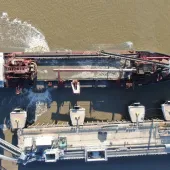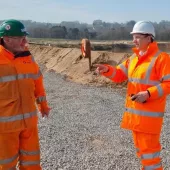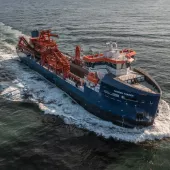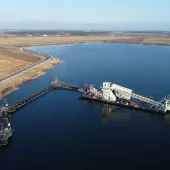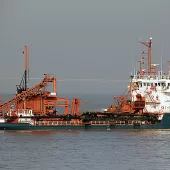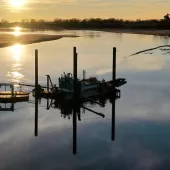A Sea Change For The Marine Aggregate Sector
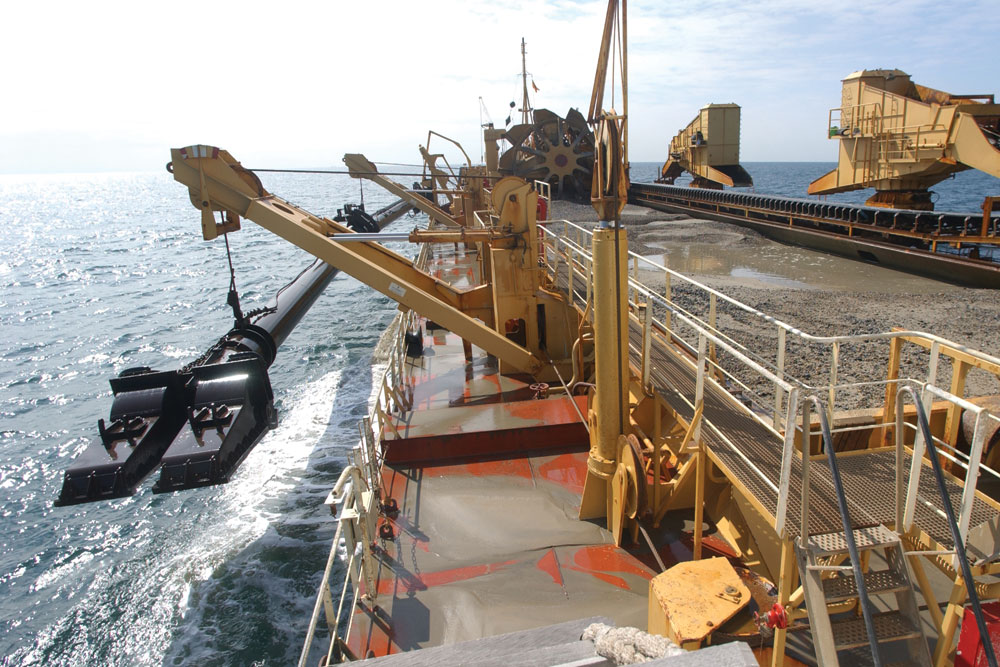
Challenges and opportunities for marine aggregate producers going forward
By Mark Russell, director, British Marine Aggregate Producers Association (BMAPA)
The UK marine area covers some 867,000km2, an area equivalent to some three-and-a-half times the UK’s terrestrial extent. Yet, unlike on land, until now the marine environment has not been subject to any sort of integrated policy, planning or management. However, thanks to the Royal Assent of the Marine & Coastal Access Act in November 2009, this is going to change, and the next few years are likely to present a number of challenges and some opportunities for the British marine aggregate industry.
The marine aggregate sector makes a relatively small contribution in terms of meeting construction aggregate demand in the UK, contributing around 6% of primary aggregate demand. However, at a national and regional scale the contribution of the sector becomes more significant – meeting around 20% of sand and gravel demand in England and Wales, around a third of the primary aggregate used in London and the South East, and 90% of the natural sand consumed in South Wales. Around 80% of all marine aggregate sales in England and Wales are used as concrete aggregate, where marine supply contributes around 18% of total sales.
Currently, 12 companies operate 26 vessels on 70 production licence areas located off the coasts of England and Wales. Licensed areas are grouped into seven broad regions, which reflect the discrete geological distribution of the relict fluvio-glacial deposits that are targeted by the industry. As of the end of 2009, a total of 1,286km2 of seabed were licensed for marine aggregate extraction in the waters around England and Wales – an area equivalent to three times the size of the Isle of Wight – of which around 124km2 is dredged in a typical year. This represents around 0.15% and 0.016% of the total UK continental shelf area respectively. A further 1,931km2 of seabed is currently under application or covered by prospecting licences. In this respect, the marine aggregate sector is responsible for managing a significant portion of the UK seabed through the exclusive licences and options operators receive from The Crown Estate.
The low value/bulk nature of construction aggregates means that they are particularly sensitive to transport costs. As a marine aggregate dredger can load, transport and deliver up to 8,500 tonnes (equivalent to 425 individual lorry loads), the economies of scale involved mean that it is possible for marine aggregate to be cost-effectively transported over considerable distances (more than 150km). This allows marine aggregate to fill gaps in resource availability around the country, often delivering cargoes into coastal urban areas, close to the point of demand.
Current production
In 2009 the UK industry produced 20.19 million tonnes of marine sand and gravel, 10 million tonnes of which was landed in England and Wales for use as construction aggregate. Of this total, more than 5.8 million tonnes was landed at wharves along the Thames estuary, equivalent to three cargoes of 5,000 tonnes being delivered every day of the year.
Some 30% of total production from UK waters – 5.7 million tonnes in 2009 – is exported to the near Continent (France, Holland and Belgium) for use as construction aggregate, making a contribution to the nation’s balance of payments. The export market exists because, as in parts of the UK, the availability of locally won terrestrial aggregates is becoming increasingly constrained – with both Holland and Belgium heavily reliant upon imports of construction aggregate from adjacent nations (Germany and France in particular, along with crushed rock by sea from Scandinavia). While both have significant volumes of fine–medium sands, which are widely exploited for beach nourishment, land reclamation and construction purposes, neither Holland nor Belgium have any significant resources of the coarse sand or gravel necessary for concrete production geologically present on their respective continental shelves. Imports are, therefore, further supplemented by marine sand and gravel from British licensed areas – particularly along the coastal strip, where the economies of scale that come from marine transport mean that large volumes can be delivered close to the urban areas where they are to be used.
Marine-dredged sands and gravels also provide a strategic role in supplying large-scale coastal defence and beach replenishment projects – more than 25 million tonnes being used for this purpose since the mid-1990s. With the growing threats posed by sea-level rise and increased storminess, the use of marine sands and gravels for coastal defence purposes will become increasingly important for the protection of coastal communities and infrastructure, particularly as there is no practical alternative source of sediment for large-scale soft engineering works. The challenges posed by flooding and coastal erosion are reflected in the fact that under the October 2010 Comprehensive Spending Review, Defra received £2 billion to address this area.
Reflecting the reduced demand for construction aggregates, BMAPA members’ production fell by nearly 25% during 2009, and by the end of that year the capacity of the dredging fleet had been reduced by 11% as five vessels were either laid up or put on to part-time working. While the marine sector’s supply into markets along the river Thames remained relatively stable during 2009, more local markets, such as those along the south coast, in the Bristol Channel and in the Irish Sea, have seen a significant reduction in production demand – a reflection of both the national and local scale of the recession.
Against this background, the overall production from marine aggregate licences only reduced by 6% during 2009, compared with the previous year. This was largely as a result of one-off contract fill projects to support major infrastructure schemes, such as the port extension at Felixstowe and the new airport development at Ronaldsway on the Isle of Man. The ability to supply a diverse range of markets represents one of the marine sector’s key strengths in responding to the challenging market conditions – whether supplying construction aggregate in the UK or overseas, providing beach nourishment material in support of coastal defence schemes, or supporting major capital infrastructure projects, such as port developments and energy installations.
Future opportunities
Looking to the future, marine sand and gravel resources are likely to play a key role in supporting the successful delivery of major infrastructure projects associated with government policies related to energy security and climate change, such as nuclear new builds, tidal power developments (albeit not in the near future), port developments and offshore wind farms.
The most recent nuclear new build, Sizewell B in Suffolk, saw 1.64 million tonnes of marine sand and gravel delivered to the site by sea. Given the coastal location of the majority of the sites identified by the Government for the current nuclear new-build programme, the sector can expect to play some role in supplying material for the construction and ongoing coastal protection of these sites.
The same is true of the Government’s ambitious offshore renewable-energy programme. With the announcement of nine Round 3 offshore wind-farm zones at the beginning of this year, and with the construction of offshore wind farms moving into deeper offshore waters, the use of gravity base foundations (GBFs) is likely to become increasingly attractive. This type of technology has already been employed at the Thornton Bank wind farm development some 30km off the Belgian coast, where 60 turbines have been installed. With the construction of each GBF requiring 1,000m3 of concrete, and a further 2,000m3 of sand for ballast fill once installed, the potential demand for marine aggregate materials could be significant. In recognition of the importance of offshore energy to both climate change and energy security, the recent Comprehensive Spending Review allocated £200 million to the Department of Energy and Climate Change (DECC) for the development of manufacturing facilities at port sites, which once again underlines the growth potential.
In order to meet these various needs, the marine aggregate sector is dependant upon identifying and licensing economically viable sand and gravel deposits to secure sufficient reserves to maintain long-term supply to existing and well-established markets. Just as on land, the locations of such deposits are extremely localized around the waters of England and Wales, being restricted in their geological distribution and in their geographical position relative to the location of the markets. However, unlike the majority of equivalent resources on land, the potential sand and gravel resource that is available offshore is considerable. Estimates suggest that resources present in existing licence and application areas are sufficient to support at least 50 years’ production, subject to the necessary consents being issued, and there are considerably more resources present on the UK shelf.
An example of the resource potential of marine aggregate deposits is demonstrated by the Maasvlakte 2 project in Holland, which is extending Rotterdam harbour into the North Sea. New licence areas have been consented on the Dutch continental shelf specifically to provide the fill material, and over the next five years a total of 250 million cubic metres of marine sand (375 million tonnes) will be dredged to reclaim the new land area. During March this year, a remarkable 3 million cubic metres of sand was dredged in a single week – equivalent to a quarter of the UK industry’s total production during 2009. Given that the size of the Dutch continental shelf is 64,000km2 or less than one tenth the size of the UK shelf area, it is possible to get a feel for the potential scale of the marine aggregate resource that is available to the UK.
The challenge for the industry is to maintain the resources that are already licensed, to secure permissions for new resources to be dredged, and to try to ensure that areas of potential resource are safeguarded from other forms of development to prevent them becoming sterilized.
Of the current licence areas, over 30 have to be renewed by the end of 2013. Each renewal will require a site-specific Environmental Impact Assessment (EIA), but this is also being supported through voluntary, industry-led Regional Environmental Assessment (REA) studies to consider regional-scale cumulative and in-combination issues. This approach has been adapted from groundbreaking work undertaken in support of new dredging permissions in the Eastern English Channel and has seen operators working together through regional associations, in conjunction with The Crown Estate, to complete four such studies. The overall objective is to make the assessment process more consistent, robust and effective for operators, regulators and consultees alike, with the site-specific EIAs then drawing on the regional findings. This fits well with government moves towards a more ecosystem approach to marine management – managing activities at a regional scale, and this is now being used as a model to assist the assessment of the current Round 3 offshore wind farm zones. Building on this still further, the industry is now also working in partnership with the Crown to develop a regional model for licence management and monitoring – again looking to deliver a more consistent, robust and effective approach to consent monitoring and management.
Evolving marine policy
Historically, the wide range of activities that take place in the marine environment have been considered in isolation from one another, often supported by sectoral policies and regulations that take little or no account of the multitude of other activities or uses that exist. The result has been growing levels of conflict and competition between activities as the UK marine area and the various resources it contains have become subject to increasing levels of pressure. This situation has arisen in the absence of a more strategic integrated planning and policy framework, similar to that which exists on land. However, it has been further compounded by the fact that, unlike on land, the marine environment is generally subject to multiple use – with shipping, fishing, aggregate extraction and recreational activities all potentially taking place over the same geographic area.
The Marine and Coastal Access Act, which received Royal Assent in November 2009, fundamentally changes marine management by introducing a more integrated, holistic approach to planning, using and protecting UK seas – an approach which is firmly grounded on the principles of sustainable development. The Act, which took around five years to develop, now provides a high-level legislative framework for the delivery of sustainable marine use and integrated planning and management. As far as the marine aggregate sector is concerned, the Marine Act will result in five principle changes: the establishment of a new Marine Management Organisation (MMO) to deliver the sustainable use of the marine environment, including planning and regulatory responsibilities; the development of a UK Marine Policy Statement to define the vision and policy priorities for sustainable marine use; a new system of marine planning; a new integrated marine licensing regime; and a new network of nationally important Marine Conservation Zones.
The development of a UK Marine Policy Statement (MPS) is well under way, and the final statement should be published by April 2011. This document will provide the high-level policy context for the development of national marine plans, and also guide decisions made under the new marine licensing regime which is also being developed. In this respect, the content of the MPS is absolutely central to securing the marine aggregate sector’s ‘licence to operate’ for the medium to long term.
From a marine aggregate perspective, the draft MPS recognizes that ‘…the UK has some of the best marine aggregate resources in the world’, and that ‘…marine sand and gravel makes a crucial contribution to meeting the nation’s demands for construction aggregate materials’. The policy document also highlights the role marine aggregate supplies play in underpinning wider government policy priorities, such as climate change adaptation (through beach nourishment), energy (eg nuclear new builds and renewable energy) and transport (port development).
In terms of the implications for planning, the draft MPS requires marine plan authorities to, as a minimum, make provision for marine aggregate supplies to contribute to the overarching government objective of ‘…securing an adequate and continuing supply to the UK for various uses’, and to take into account ‘…the potential long-term requirement for marine-won sand and gravel, taking into account trends in construction activity, likely climate change adaptation strategies and major project development’. For the first time, the MPS also acknowledges the need to potentially safeguard reserves for future extraction.
Translating the policy objectives and visions of the final MPS into delivery on the ground will be a new process of integrated marine planning instigated at a national scale – a first for UK waters. Each of the devolved administrations is responsible for delivering marine planning in their own jurisdiction; and in English waters, where the majority of UK marine aggregate interests lie, the responsibility for delivery rests with the new Marine Management Organisation. Ten marine plan areas have been defined for English waters, covering both nearshore (within 12 nautical miles) and offshore (beyond 12 nautical miles) areas, and marine aggregate interests can be found within seven of these. As a consequence, the development of the marine planning process will be of central importance to the industry – both in terms of maintaining the current licensed interests as well as looking to the future. The planning process, which will commence in April 2011, will see two plan areas (expected to be adjacent nearshore/offshore areas) developed in parallel with one another, with each regional plan taking two to three years to be completed. Similar processes will also be taking place in Welsh, Scottish and Northern Irish waters.
At the end of October 2010 the first two English marine plan areas were announced by the MMO. Collectively, they cover an area of the southern North Sea extending from Flamborough Head in Yorkshire to Felixstowe on the Suffolk/Essex border. This area incorporates a wide range of ongoing activities, including significant offshore renewable energy developments, carbon capture and storage, and European marine protected sites, as well as the Humber and East Coast dredging regions, which collectively comprise around 50% of the sector’s current production. The planning process is very much in its infancy, and as such there are considerable advantages for the industry in being directly involved in the first plans to be developed.
The advent of the Marine and Coastal Access Act has resulted in a sea change in the way that the marine environment is planned, used and protected. Each of the components introduced by the Act represents a significant step change in the way that the marine aggregate sector will be regulated and managed. With all these changes occurring in parallel with one another, the challenges facing the industry in responding to the policy and management changes over the next few years will be considerable. But, at the same time, these challenges have to be balanced against the significant opportunities that exist in being able to develop a more robust and certain future for the industry going forward in the medium and long term. Given the resource potential of UK marine aggregate resources and the range of strategically important policy areas they can support, the long-term outlook for the marine aggregate industry looks bright.

